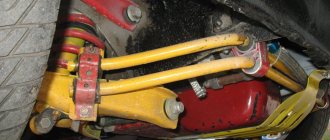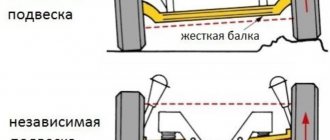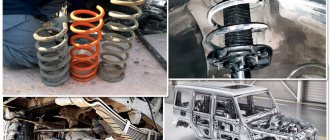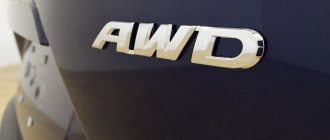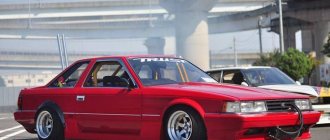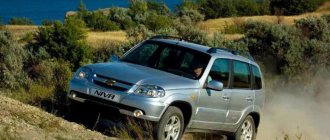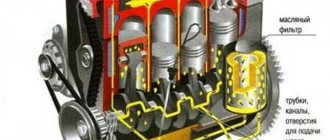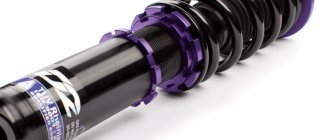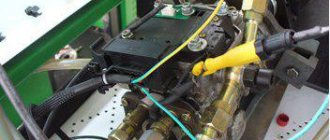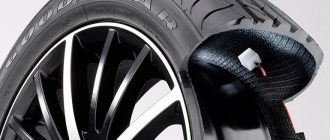Independent suspension is the most popular type of suspension. It differs from others in that each wheel does not affect the others, and there is no rigid connection between the wheels. There are many types of independent suspension, but the most popular is the multi-link MacPherson strut. It differs from others in its good characteristics and relatively low cost.
Independent suspension
In modern brands of cars, the vibration damping device operates separately on each wheel. Colliding a car with an obstacle on one side, in principle, does not have a large impact on the body. The independent suspension works effectively, which means that vibration and shock from road irregularities are completely dampened.
The complex design of the device consists of a whole list of elements that coordinately participate in maintaining a stable position of the car body in motion.
You will have to spend money on maintenance and repair of independent suspension. This type of spring device is chosen for the sake of comfort and good handling of a truck or all-wheel drive vehicle. Popular on the independent list of many brands of passenger cars is the rear chassis of the MacPherson brand.
Independent suspension
A little theory
Depending on its design, a car's suspension can be divided into two main categories: dependent or independent. In a dependent suspension on one axle, the wheels are rigidly interconnected; accordingly, the impact that falls on the left or right wheel will invariably affect the entire rigid beam and the second wheel on the axle. When passing uneven surfaces, the body will tilt or shudder, and if one wheel on the road surface is higher than the other, then in such a case the likelihood of the body tipping over increases.
The independent suspension does not have a rigid beam; accordingly, the wheels on the axle are not rigidly interconnected with each other, which can significantly increase comfort on board, improving the vehicle's handling. If one of the wheels hits an obstacle or falls into a hole, then due to the lack of interconnection, such impacts are not transmitted to the second wheel and the car body. This significantly improves the car's handling characteristics.
Which is better - dependent or multi-link suspension?
The purpose of any spring device is to protect the car body from external impacts of road irregularities on the front and rear wheels. A multi-lever does this job well - a complex elastic structure. A dependent suspension is simpler and cheaper than a semi-independent one. But in modern cars this device is practically not used.
Different types of multi-link or semi-independent chassis of a car or truck have both advantages and disadvantages.
The advantage of semi-independent suspension is low weight, good handling and silent operation. This means tight grip on the road surface even at high speeds.
The advantages of a dependent front or rear suspension of a truck or passenger car are its simple, durable design and reliability.
Suspension with virtual steering axis
This suspension is used on Volkswagen Phaeton passenger cars. When the front wheel is suspended on four arms, its rotation axis does not pass through the upper and lower hinges of the rotary strut, as is the case with known suspension designs, but through the intersection points of the extended axes of the upper and lower arms.
Rice. Suspension with a virtual axis of rotation of the wheel: 1…4 - directions of the longitudinal axes of the levers; R - wheel center; A is the center of the wheel support surface; n is the offset of the rotation axis relative to the center of the supporting surface; nv — offset of the turning axis relative to the center of the wheel; p—rolling shoulder; a is the arm of action of disturbing forces; AS - the point of intersection of the wheel turning axis with the road plane
Thus, the steering axis of the wheel is located, as it were, in free space and changes its location when the wheel is turned. Therefore, such a wheel rotation axis is called virtual. This design allows you to significantly bring the wheel’s turning axis closer to its middle plane. This has a positive effect on the values of the roll-in arm and the arm of the disturbing forces, thereby improving the vehicle's handling and stability characteristics.
Types of independent suspensions
The location and connection into the system of a whole list of damping device parts depends on the type of vehicle chassis. The main purpose is to dampen shocks, body vibrations and maintain directional stability.
List of types of independent front and rear suspensions:
- swing axle shafts;
- longitudinal, oblique and double wishbones;
- multi-lever.
According to the rating, an advantage was noted for the MacPherson chassis, which is usually found on the rear axles of many passenger car brands due to its good price-quality ratio. All independent suspensions differ in that they allow each wheel to react to obstacles separately.
Suspension with swing axles
In older domestic brands of cars, the chassis ensures that the wheel axis is vertical relative to the road. The axis itself appears to be divided into two halves. Each part is rigidly connected to the wheel hubs. The work of the damper in the device is performed by shock absorbers and spring blocks.
The axle shafts are connected on the inside by a hinge unit. On uneven roads, the track and camber of the front and rear discs have a large amplitude, which reduces safety.
Trailing arm suspension
An elastic device stabilizes the position of the body using springs or torsion bars. The design is often used on front-wheel drive vehicles. The trailing arms are attached to the body on one side and to the wheels of the car on the other.
The suspension is easy to maintain and repair, but has one drawback: it does not cope well with body roll when cornering. The chassis does not allow you to maintain a constant wheelbase while moving.
Slanting wishbone suspension
In this damping device, the parts appear to be located at an angle to the wheel. Which means that the design effectively maintains the stability of the car body during any maneuvers. And maintains a constant wheel angle when cornering. But when hitting bumps and holes, the stability of the car decreases.
To neutralize the negative properties of suspension on oblique arms, torsion bars and springs are used. These elastic devices increase the stability of the car on uneven roads.
Double wishbone suspension
The design has a rigid attachment to the car body and works as an independent unit. This ensures controllability and good stability of the car on the road.
The levers in the independent front or rear suspension are located transversely and connected to the strut supports. On the front wheels, shock absorbers can rotate around a vertical axis. Elastic parts of the chassis - springs, pneumatic and hydraulic devices.
Multi-link suspension
This design is more often used in luxury cars on the rear axle. Many parts in the device better dampen multidirectional vibrations, thereby increasing the directional stability of the machine.
Multi-link suspension
The principle of a multi-link automobile suspension is the transverse arrangement of independently working parts. A special feature of the spring design is good smoothness and controllability, which also means silent operation when moving.
Technical nuances
Now let’s move on to the technical side of the issue and understand the design and structure of the dependent system, as well as its varieties. Similar types of pendants include the following:
- on longitudinal springs (spring);
- with guide arms (dependent spring);
- De Dion pendant.
The first option is one of the oldest. This structure consists of a bridge beam connecting two wheels, as well as two longitudinal springs on which it is attached.
The spring in this embodiment acts as a universal elastic element - it takes on loads in the vertical and transverse planes, and also dampens body vibrations. Of course, you cannot achieve high comfort from the operation of the suspension of such a system, and at high speeds, problems with controllability begin to appear.
A design with guide arms can be called more advanced and modern. There are a lot of design options in terms of the number of levers and their configuration - this includes a suspension with a Panhard rod, and with a Watt or Scott-Russell mechanism. Compared to spring systems, these systems have much better handling and cornering behavior. The main elastic element here is the spring, and the shock absorber helps it.
As for the De Dion pendant, there is one nuance. The fact is that this system cannot be called completely dependent due to the tricky arrangement of the elements, which is due to the fact that it was developed for the rear axle of rear-wheel drive cars. In it, the differential and the beam connecting the wheels are separated.
We recommend: How to drive a manual car
The differential is rigidly connected to the car body, and rotation from it to the wheels is transmitted through swinging drive shafts. According to experts, the De Dion suspension is superior in many respects to the best examples of independent designs, and its only significant drawback is the price, which is why you can rarely see it, and even then mainly on sports cars.
Disadvantages and advantages of independent suspensions
The positive side of the spring design is the ability to adjust the chassis of a passenger car to maintain comfortable driving conditions. This means that the elastic elements create good contact on any road surface.
List of the main advantages of independent suspension:
- controllability in motion;
- smooth running of the machine;
- reduced roll when cornering;
- independent adjustment of the position of the front and rear wheels.
However, levers and beams, and other elements of the assembly quickly wear out during operation.
Here is a list of disadvantages of independent suspensions:
- complex design;
- expensive production and maintenance of the device;
- low maintainability due to many parts.
Therefore, complex spring structures are usually used in expensive brands of passenger cars.
Similarities and differences
Both pendants serve the same purpose. They are needed to make car travel safer and more comfortable.
In terms of design, what they have in common is that in both cases elastic elements, shock absorbers and guides are used. A striking example is the use of springs. Some actively mount air bags into springs to increase comfort.
But there are much more differences between them:
Application
As stated above, the design of independent suspension is complex. The unit consists of many parts. Due to an increase in the contact area of dependent moving parts, the reliability of the entire structure decreases. In this regard, multi-lever is rarely used in economy passenger cars. Independent suspension is often installed on the rear axle of crossovers and all-wheel drive SUVs.
The significance of the device is to ensure good grip on the road surface and stability of a car with front-wheel drive or all-wheel drive. At the same time, multi-link suspension on two axles can only be found in the list of modern luxury car brands.
What voltage should be on a car battery in different modes
- The wheels of the dependent system have a rigid connection, making them dependent on each other. The competitor's wheels work independently;
- Independent units have more unsprung masses, which is due to the absence of a bridge;
- Independent is more sensitive to wheels that do not meet the automaker's requirements;
- The likelihood of capsizing during a sharp turn or when falling into a hole on a car with independent auto suspension is less due to the lack of a rigid connection of the wheels.
As you can see, there really is a difference, and it is significant in many ways. What exactly to choose, everyone decides for themselves.
Basic elements of a car suspension
Any pendant consists of several basic elements:
Tires. This is the first stage in the system for smoothing out uneven road surfaces. Having a certain degree of elasticity, the tire is able to dampen a small amount of vibrations that occur during movement. If there are malfunctions in the tire suspension, the wheels can act as an indicator of a malfunction, since the service life of the tire in such a situation is quickly reduced and uneven wear occurs.
Basic elastic elements. The elastic elements of a car suspension include springs, leaf springs and torsion bars. The purpose of these elements is to provide an elastic connection between the body and the road surface. The entire load of the car falls on the springs, and due to their elasticity, the body is held at a certain height. During operation and heavy overloads, the metal of the elastic elements wears out, causing their rigidity to change. Such changes negatively affect the performance of the suspension as a whole. The angle of the wheels changes, the ground clearance decreases, and the load capacity decreases. Body sagging when unloaded is the main signal that the springs need to be replaced.
Additional elastic elements. Additional elastic elements include compression buffers; their use is necessary to dampen high-frequency vibrations, as well as vibrations generated during the contact of metal elements. Thanks to the presence of such elastic elements, the service life of other suspension components is significantly increased.
It is extremely important to monitor their good condition and promptly replace worn parts.
Guiding devices. The main task of the guide devices is to ensure the movement of the wheel in the established plane. Thanks to a system of levers, when moving on an uneven surface, the wheel moves in a vertical direction, while maintaining a perpendicular position relative to the road surface
Any violations in the guide elements will lead to rapid and uneven wear of the wheel tire, as well as other suspension elements.
Damping element. The element of the damping device is a shock absorber. The use of shock absorbers in the suspension system allows you to solve problems such as body vibration when driving on uneven roads, as well as smoothing out vibrations on other elements of the vehicle's suspension. Thanks to the damping function, constant contact of the wheel with the road is ensured, the car becomes more stable when driving.
Anti-roll bar. When turning at speed, the anti-roll bar prevents the vehicle from rolling. When performing a turning maneuver, the wheels on one side of the vehicle begin to lift off the road, which can cause the vehicle to roll over. At this moment, tension is created on the stabilizer, which tends to return the rising edge of the car to its place.
Fastening elements for individual parts. Fastening elements include ball joints, silent blocks and bolted joints that connect the remaining elements of the vehicle's suspension.
Principle of operation
The operation of a car's suspension is based on the conversion of the impact energy arising from a wheel hitting an uneven road surface into the movement of elastic elements (for example, springs). In turn, the rigidity of the movement of elastic elements is controlled, accompanied and softened by the action of damping devices (for example, shock absorbers). As a result, thanks to the suspension, the impact force that is transmitted to the car body is reduced. This ensures smooth running. The best way to see the system in action is to use a video that clearly demonstrates all the elements of a car's suspension and how they interact. » alt=»»> Cars have suspensions that vary in stiffness. The stiffer the suspension, the more informative and efficient the car control. However, this seriously compromises comfort. And, on the contrary, the soft suspension is designed in such a way that it provides ease of use and sacrifices controllability (which cannot be allowed). That is why car manufacturers are striving to find their best option - a combination of safety and comfort.
